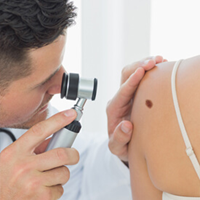About Mohs Surgery
Our board-certified dermatologist, Dr. Yang Xia, is an excellent Mohs micrographic surgery provider for patients with skin cancer. Mohs surgery at SkinMD has one of the highest success rates for the elimination of squamous cell and basal cell carcinomas. Patients with melanomas or other tumors may also benefit from this surgery. During the procedure, Dr. Xia begins by thoroughly removing the cancerous cells one layer at a time. After each layer, Dr. Xia will inspect the cell makeup of your skin under a microscope to find out whether or not the cancer is still present. It also does not require general anesthesia, which makes Mohs surgery available to men and women who cannot be put under because of the health consequences. If you would like to learn more about Mohs surgery, please schedule a surgery consultation to see Dr. Xia at our Hurst or Weatherford, TX office of SkinMD.
Mohs Surgery Reviews
Ideal Candidates
Mohs surgery is largely utilized to take care of the two most prevalent kinds of skin cancer, including squamous cell carcinoma and basal cell carcinoma, as well as a selection of other skin cancer subtypes. If you're suffering from melanoma or a different kind of uncommon skin cancer, an appointment can help determine if you're an ideal candidate for this type of excision surgery.
If you are at high risk of having a recurrent type of skin cancer, then Mohs surgery is the ideal choice for your treatment. The cancer cells may even be found in sensitive places, like the ears, eyes, mouth, or nose. Skin cancer cells that are big, aggressive, and have border irregularities that are tough to specify are also better handled with Mohs surgery.
Surgical Technique
On the day of your surgery, Dr. Xia will use local anesthetics to numb the affected region before two incisions are created. There is no need to have general anesthesia for Mohs surgery. Once you are numb, he will make the incisions and start the process of removing the cancer layer by layer. The excised layers are analyzed under a microscope. When extra cancer follicles are detected, they're indicated with the corresponding map and the procedure is repeated. Dr. Xia will repeat this process over and over until all of the cancer is removed.
The number of layers eliminated and the duration of the surgery will depend on your specific type of cancer and the severity of the cancer growth. Your Mohs surgery will leave a surgical scar and we will educate you on how to best manage your skin with healthy solutions and scar care.
What to Expect
The Mohs surgery process is not an easy solution, but by choosing a proficient team and the right type of local anesthesia, many patients report minimal pain. Mohs surgery is generally completed on an outpatient basis, with patients able to drive home later. Even though the treated site will be bandaged, it's likely you can resume your activities the following day. This rules out any vigorous exercise or significantly heavy tasks for as much as two weeks. If sutures were used, Dr. Xia will schedule you a follow-up appointment for them to be taken out in 6 – 14 days. Scarring for each patient will differ based upon the type of treatment selected and performed. The success rate of eliminating the cancerous cells is quite high when treating main basal cell carcinoma, with thin melanomas achieving around a 99% cure rate. Primary squamous cell carcinoma has a bit of a lower treatment rate, at around 97%.
You Deserve Superior Care
When confronting a skin cancer diagnosis, it's crucial to do thorough research and locate a skilled Mohs surgeon who is an ideal match for your own expectations and needs. Success rates of Mohs surgery are directly connected to a physician's ability and expertise. To find out more about the expertise, training, and success rates of Dr. Xia, contact SkinMD today in Hurst or Weatherford, TX to schedule an appointment.




